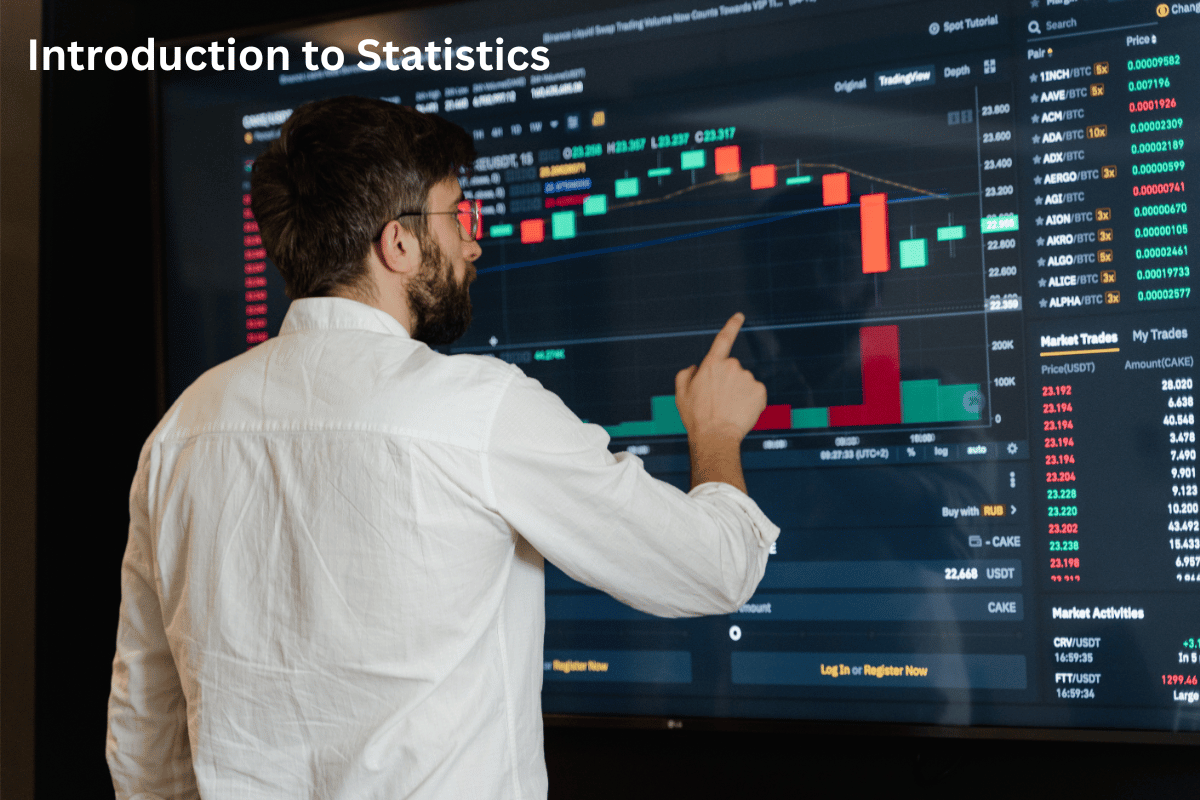Introduction to Statistics: Discover the Basics
Did you know that Stanford University’s Introduction to Statistics course on Coursera has engaged over 477,842 learners? It has earned top ratings of 5 consistently. This shows how important and interesting statistics for beginners is. Learning the basics of statistics opens doors in fields like healthcare, business, and social sciences.
Statistics is more than just numbers. It’s a way to make smart choices with data. This statistics tutorial simplifies tough ideas for newcomers. It’s great for anyone looking to understand data from studies or spot trends.
Experts and top materials make learning statistics easy. This course gives you a deep understanding of statistics basics. As you learn, you’ll get better at using data in your work and studies.
Key Takeaways
- Introduction to Statistics course by Stanford is highly rated with consistent 5-star reviews.
- Engages over 477,842 learners, making it a popular choice for beginners.
- Covers essential topics without requiring advanced mathematical background.
- Flexible learning pace, suitable for working professionals and students alike.
- Practical, real-world applications of statistical concepts enhance learning experience.
- Completion certificates can boost professional and academic profiles.
- Contains a variety of learning materials including videos, simulations, and case studies.
What is Statistics?
Statistics is a key part of mathematics that helps us collect, analyze, and understand data. It comes from the German word “Statistik,” meaning “description of a state or a country.” Over time, it has grown to include data analysis in many areas like psychology, geology, sociology, and weather forecasting.
Definition and Overview
Statistics is vital for making sense of complex data. It uses tools like mean, median, mode, variance, and standard deviation to summarize data. By applying math, such as linear algebra and probability theory, it helps us understand and analyze numbers.
It also uses graphs like bar graphs, pie charts, line graphs, and histograms to make data easier to understand.
Importance of Statistics in Various Fields
Statistics plays a big role in many fields. In business, it helps make decisions based on data. In healthcare, it improves patient care through research and analysis. Government policies often rely on statistical data, and technology uses it for predictive algorithms.
Difference Between Descriptive and Inferential Statistics
Statistics has two main branches: descriptive and inferential. Descriptive statistics summarizes data with tools like mean and standard deviation. For example, it uses mean, median, mode, variance, and standard deviation to summarize data.
Inferential statistics, on the other hand, uses samples to make predictions about a bigger group. Techniques like regression analysis, ANOVA, and null hypothesis testing are key here. Knowing the difference between these two is important for understanding statistics.
Key Statistical Concepts
Learning key statistical concepts is crucial for those new to statistics. These ideas help build a strong base for understanding and using data in different areas. They prepare you for more complex topics in data analysis.
Data and Data Types
Data is the collection of numbers, words, or other info analyzed for insights. It’s divided into two main types: qualitative data and quantitative data. Qualitative data is descriptive and can’t be counted. Quantitative data is either discrete, with fixed values, or continuous, measured on a scale.
Population and Sample
Understanding the difference between a population and a sample is key in statistics. A population is all possible observations. A sample is a smaller part of the population analyzed. For example, a study might find the average car value in a sample of 200 cars is $8,357. This is close to the true average value of all cars.
Also, if 172 out of 200 cars are under six years old, the sample shows 86% are. This is close to the true percentage of all cars.
Variables and Measurement Levels
Variables are the traits or features of data. They can be measured at four levels: nominal, ordinal, interval, and ratio. These levels help us collect and analyze data systematically:
- Nominal: These are categorical data with no order (like gender or nationality).
- Ordinal: These are categorical data with an order but no set intervals (like rankings).
- Interval: These are numerical data with equal intervals but no zero point (like temperature).
- Ratio: These are numerical data with a true zero, allowing for absolute comparisons (like height or weight).
Knowing these concepts helps with better data analysis and using statistical tools correctly. This knowledge is vital for thorough and meaningful statistical analysis in various fields.
| Sample Statistics | Population Statistics |
|---|---|
| Sample Mean (\(\bar{x}\)): $8,357 | Population Mean (\(\mu\)): Estimated |
| Sample Proportion (\(\hat{p}\)): 86% | Population Proportion (\(p\)): 86% |
| Sample Size: 200 | Population Size: Unknown |
| Quantitative Data: Discrete & Continuous | Qualitative Data: Descriptive |
Data Collection Methods
Understanding data collection practices is key for making good decisions and getting accurate stats. It’s a big part of statistics basics. It lays the groundwork for all data analysis.
Sampling Techniques
Sampling is vital for getting data that truly represents a bigger group. Methods like simple random sampling and stratified sampling make sure the sample is a good match for the population. This makes the data analysis more reliable. Proper sampling is a key part of data collection practices. It helps guide data analysis techniques.
Experimental vs Observational Studies
Experimental and observational studies are the heart of many research projects. Experimental studies let researchers change things to see how they affect outcomes. Observational studies, on the other hand, just record data without changing anything. Knowing these methods is key to using statistics basics and picking the right statistical methods.
Common Data Collection Tools
Many tools help with collecting data, each fitting different research needs. Surveys and questionnaires are great for getting lots of data quickly. Observations, interviews, and case studies give deep insights. Using software also makes data analysis techniques more precise and scalable.
| Data Collection Tool | Type | Advantages | Disadvantages |
|---|---|---|---|
| Surveys | Quantitative | Efficient for large groups | Potential bias in responses |
| Questionnaires | Quantitative & Qualitative | Structured data collection | Requires careful design |
| Observations | Qualitative | Real-time data collection | Time-consuming |
| Interviews | Qualitative | In-depth information | Resource-intensive |
| Case Studies | Qualitative | Comprehensive insights | Not generalizable |
In conclusion, getting good at these data collection practices helps researchers and analysts collect data well. This leads to trustworthy and insightful statistical analysis.
Descriptive Statistics
Descriptive statistics are key in making big data easy to understand. They summarize data with measures of central tendency and spread. These measures help us see what the data looks like.
Measures of Central Tendency
Central tendency measures give us a central value where most data points cluster. They are vital in statistics.
- Mean: The average of all data. Sample Mean: 33.80, Population Mean: 43.18.
- Median: The middle value when data is sorted.
- Mode: The most common value in the data.
Measures of Spread
Spread measures show how spread out the data is. This is important in descriptive statistics.
- Range: The biggest and smallest values’ difference.
- Interquartile Range: The third quartile minus the first quartile.
- Variance: How much data varies from the mean.
- Standard Deviation: Variance’s square root, in the same units as the data.
- Coefficient of Variation: Standard deviation compared to the mean.
- Skewness: How uneven the data distribution is.
- Kurtosis: How peaked the distribution is.
Data Visualization Techniques
Data visualization helps us understand descriptive statistics better. It shows patterns and outliers in the data.
- Pie Charts: Show data in a circle.
- Bar Graphs: Great for comparing different groups.
- Histograms: Show how often data values occur.
- Box-and-Whisker Plots: Summarize data with five numbers and highlight outliers.
- Scatter Plots: Find relationships between two data sets.
The image shows how data visualization helps in presenting descriptive statistics.
Here’s a table that explains some key descriptive statistics:
| Metric | Description | Example Value |
|---|---|---|
| Mean | Average of data set | Sample Mean: 33.80 |
| Median | Middle value | N/A (depends on the data set) |
| Mode | Most frequent value | N/A (depends on the data set) |
| Range | Largest value – Smallest value | N/A (depends on the data set) |
| Variance | Average squared deviation from mean | N/A |
| Standard Deviation | Square root of variance | N/A |
| Skewness | Asymmetry of distribution | N/A |
| Kurtosis | Peakedness of distribution | N/A |
Introduction to Probability Theory
Probability theory is key to understanding statistical analysis. It helps us measure uncertainty, randomness, and risk with numbers. By learning basic statistics, we can apply these ideas to real life. This improves how we interpret data and make decisions.
Basic Probability Rules
Probability theory has basic rules that are vital for statistical analysis. These rules include the complement rule and the multiplication rule. They help us figure out the chances of events happening or not happening together. Events can either be separate or cover all possibilities. A sure event always happens, and an impossible event never does. Probabilities are numbers between 0 and 1, making calculations clear.
Probability Distributions
Probability distributions are functions that show the chances of different outcomes. For example, flipping a fair coin gives us a uniform distribution. Rolling two dice gives us a more complex pattern. Knowing these distributions is key for understanding data and doing statistical analysis.
Bayesian vs Frequentist Interpretations
When analyzing data, we often choose between Bayesian and Frequentist views. The Frequentist view sees probability as the long-run chance of an event. The Bayesian view uses prior knowledge and reasoning to guess uncertain outcomes. This choice is important in many areas, like machine learning and artificial intelligence, where uncertainty is a big part.
| Interpretation | Definition | Example Applications |
|---|---|---|
| Frequentist | Defines probability as the relative frequency of an event occurring in the long run. | Long-term trends, quality control, clinical trials. |
| Bayesian | Considers probability as uncertain knowledge based on prior information and cognitive reasoning. | Decision-making, machine learning, dynamic systems. |
Understanding these different views is crucial for better data interpretation. It helps us tackle statistical analysis from different angles.
Inferential Statistics
Inferential statistics help researchers make decisions about a whole group from a small sample. It goes beyond just listing data. It helps predict and test ideas about the patterns and effects.
Hypothesis Testing
Hypothesis testing checks our guesses about big groups. It starts with a null hypothesis (H0) saying there’s no effect. Then, it has an alternative hypothesis (H1) saying there is a big effect.
Statistical significance comes from p-values in hypothesis testing. If a p-value is less than 0.05, we usually say the null hypothesis is wrong. This means the effect is likely real and not just by chance.
Confidence Intervals
Confidence intervals give us a range where we think the true value might be. For example, a 95% interval means the true value should be in this range 95% of the time if we kept taking samples.
The Central Limit Theorem is key here. It says that as the sample size grows, the average of the samples gets closer to a normal distribution. This is true if the original data isn’t normal, especially with samples over 30.
P-values and Statistical Significance
P-values are vital for seeing if results are statistically significant. If a p-value is under 0.05, it means we have strong evidence against the null hypothesis. A p-value over 0.05 means we don’t have enough evidence to say the null hypothesis is wrong.
The power of a hypothesis test shows how well it can spot false null hypotheses. It’s the opposite of Type-2 error (β). Bigger samples make these tests more powerful, giving us more reliable results and fewer false conclusions.
| Concept | Description |
|---|---|
| Hypothesis Testing | Process of making inferences about population parameters using null and alternative hypotheses. |
| Confidence Intervals | Provides a range for an estimated parameter with a specified likelihood. |
| P-values | Indicate the strength of evidence against the null hypothesis. |
| Statistical Significance | Determined when p-values are less than the significance level, usually 0.05. |
Common Statistical Tests
When diving into data analysis, knowing about statistical tests is key. Tests like the z-test, t-test, Chi-Square Test, and ANOVA are vital. They help find links between variables, check hypotheses, and make sense of data.
z-test and t-test
The z-test and t-test are basic in statistics. They’re used to compare means under different conditions. The z-test is for large samples with known population standard deviation. The t-test is for smaller samples or unknown standard deviation. Both tests are crucial for testing hypotheses by finding the chance of group differences.
Chi-Square Test
The Chi-Square Test looks at how categorical variables are linked. It checks if the actual and expected frequencies in a table are the same. For instance, it can show if gender affects voting. A low P value means the link is unlikely by chance.
ANOVA (Analysis of Variance)
ANOVA helps see if different groups have the same mean. It’s vital in studies with many groups. By looking at the F-ratio, we can tell if differences are real or random.
| Test | Type | Applications | Key Assumptions |
|---|---|---|---|
| z-test | Parametric | Comparing means for large samples | Known population variance |
| t-test | Parametric | Comparing means for small samples | Unknown population variance |
| Chi-Square Test | Non-parametric | Association between categorical variables | Independence of observations |
| ANOVA | Parametric | Comparing means of multiple groups | Equal variances among groups |
Choosing the right statistical test is crucial. It depends on the question, data, and study design. Knowing about z-test, t-test, Chi-Square Test, and ANOVA helps researchers make strong conclusions and grow their fields.
Introduction to Statistical Software
Statistical software is a key tool in today’s data analysis world. It helps researchers and professionals understand complex data better. These tools make data analysis more efficient and accurate, which is crucial for deep insights.
Popular Software Tools (SPSS, SAS, R)
Three software packages stand out in data analysis: SPSS, SAS, and R. Each has unique features that meet different analytical needs:
- SPSS: It’s easy to use and popular in social sciences and business. SPSS makes handling data and running statistical tests simple.
- SAS: SAS is great for complex data and advanced analytics. It’s essential in healthcare, finance, and life sciences.
- R: R is a favorite in academia for its wide range of packages and flexibility in analysis and visualization.
Advantages of Using Software for Data Analysis
Using statistical software in research has many benefits:
- Increased Efficiency: It automates tasks, saving time and effort.
- Accuracy: It reduces errors, ensuring precise results for informed decisions.
- Flexibility: It meets the needs of various industries with its diverse tools.
- Scalability: It easily handles large datasets, perfect for detailed analyses.
- Visualization: It offers advanced graphics to better understand and share data insights.
Basic Commands and Functions
Knowing basic commands and functions boosts the use of statistical software. Here’s a quick look at some basics:
| Software | Basic Commands | Functions |
|---|---|---|
| SPSS | FREQUENCIES, DESCRIPTIVES, T-TEST | Data visualization, Regression analysis |
| SAS | PROC MEANS, PROC FREQ, PROC REG | Predictive modeling, Data mining |
| R | summary(), plot(), lm() | Statistical tests, Machine learning |
Learning these commands is a step towards better data manipulation and analysis. It improves the quality and efficiency of your research.
Data Interpretation and Analysis
Understanding data interpretation and analysis is key to turning raw data into useful information. This helps improve decision-making. By using different data analysis techniques, one can understand statistical results, check for errors, and apply statistics in real situations.
Reading Statistical Outputs
Reading statistical outputs means knowing how to understand stats like mean, median, and standard deviation. It also means understanding p-values, confidence intervals, and correlation coefficients. These skills are crucial for making accurate decisions based on the data.
Error Analysis
Error analysis checks how accurate and reliable the data is. It looks at different types of errors, like systematic or random ones. By finding and fixing these errors, analysts make sure their data analysis is trustworthy. This makes the statistics used in various fields more reliable.
Practical Applications
Statistics are used in many areas, like healthcare, finance, and marketing. They help solve problems, predict outcomes, and suggest actions. By using different analysis techniques, we can understand data, make predictions, and guide decisions.
Here’s a quick look at different data analysis techniques and where they’re used:
| Analysis Technique | Description | Application |
|---|---|---|
| Descriptive Analysis | Summarizing data using mean, median, mode, and standard deviation. | Creating charts and graphs to present key statistics. |
| Inferential Analysis | Drawing conclusions from sample data to make predictions about a population. | Hypothesis testing to validate research questions. |
| Predictive Analysis | Using past data trends to predict future events through algorithms. | Forecasting sales trends and customer behavior. |
| Prescriptive Analysis | Identifying the best course of action based on analyzed data. | Optimizing business processes and decision-making. |
| Exploratory Data Analysis | Analyzing data to find unknown relationships and patterns. | Identifying potential insights for further analysis. |
| Causal Analysis | Determining cause and effect relationships between variables. | Understanding the reasons behind certain outcomes and trends. |
Building Statistical Models
Building statistical models is key in finance, risk management, and scientific research. These models help make better decisions by using data to predict outcomes and find patterns. They can be simple or complex, from linear regressions to multivariate analyses.
There are two main types of machine learning models: supervised learning models and unsupervised learning models. Supervised learning models, like logistical and linear regressions, help forecast and understand relationships. Classification models, using algorithms like decision trees, sort through huge datasets.
On the other hand, unsupervised learning models group similar data points together. Reinforcement learning trains algorithms by rewarding good outcomes and penalizing bad ones. These methods are vital for predictive analytics, helping to understand and predict data patterns.
Knowing about statistical models is crucial for picking the right ones for your data. This means preparing your data by cleaning and organizing it. By learning statistical prediction, experts can share their findings more effectively with others.
For those starting in data science, getting advanced degrees in analytics with a focus on machine learning is a good start. Certificates like the SAS Statistical Business Analyst Professional Certificate offer practical experience. Online courses on Coursera can also help improve skills in statistical modeling and advance your career.
The need for data modeling skills is growing in many industries. Companies use these models to make strategic decisions. Being able to analyze and predict with advanced statistical tools is a valuable skill in the job market.
Exploratory Data Analysis (EDA)
Exploratory Data Analysis (EDA) is a key step in data analytics. It uses data exploration techniques to highlight the main features of a dataset. This includes using visuals to get initial data insights and find hidden patterns and anomalies.
A dataset about employee salaries has 148,654 rows and 13 columns. It includes details like Id, Employee Name, and Job Title. To start EDA, methods like describe() in pandas give summary stats for numbers.
Key techniques in EDA include:
- Handling Missing Values: It’s important to deal with missing data. Strategies include imputing or dropping rows.
- Data Visualization: Charts like histograms and scatter plots help show data and relationships.
- Outlier Detection: Finding and managing outliers is crucial to avoid skewed results.
The table below shows important EDA functions:
| Function | Description |
|---|---|
describe() |
Shows summary stats for numbers |
info() |
Summarizes data, including types and non-null counts |
nunique() |
Counts unique values in each column |
| Histograms, Boxplots, Scatter Plots | Visuals to understand data and relationships |
By doing EDA well, analysts get valuable data insights. This makes a strong base for further modeling and testing. Tools like NumPy, Pandas, Matplotlib, and Seaborn in Python help make EDA easier and more insightful.
Challenges and Pitfalls in Statistical Analysis
In the world of statistical analysis, many challenges can make it hard to draw correct conclusions. It’s important to know about common statistical errors and watch out for pitfalls. Keeping data analysis ethical is also key to avoid misuse and wrong representation.
Common Errors and Misconceptions
Errors like protocol violations and issues with outcome assessment can harm the trustworthiness of clinical trials. Leaving out participants who didn’t follow the rules can break the randomization principle and add bias. This can lessen the study’s power, especially with big samples.
Using only data from those who followed the protocol can make treatment effects seem better than they are. This is different from the intention-to-treat analysis. It keeps groups fair and removes bias.
| Analysis Type | Advantages | Disadvantages |
|---|---|---|
| Intention-to-Treat (ITT) | Preserves comparability, eliminates bias, maintains sample size | May underestimate the treatment effect |
| Per-Protocol (PP) | Reflects actual adherence to protocol | May exaggerate treatment effect, violates randomization |
Ethical Considerations
Being ethical in data analysis means being honest during all steps of the process. The CONSORT guidelines suggest reporting both ITT and PP analyses for a full picture in randomized trials. Not following these rules can lead to biased results and damage trust. In noninferiority trials, PP analysis is crucial for a strong trial.
How to Avoid Pitfalls
To overcome statistical challenges, there are steps to take. Problems like overfitting and p-hacking can be lessened by pre-registering studies and ensuring they can be repeated. It’s also important to handle many comparisons right, using methods like the Bonferroni correction and the Benjamini and Hochberg procedure to keep errors in check.
But, being too strict can increase the chance of missing real effects. It’s important to balance this. Checking study quality, verifying findings with other research, and focusing on main results can help avoid these issues.
Introduction to Statistics: A Step-by-Step Guide
Starting an introductory statistics course is a great way to learn about data analysis. It’s perfect for beginners or those looking to improve their knowledge. There are many statistics learning resources to help you along the way.
Recommended Courses and Resources
One top course is Stanford University’s “Introduction to Statistics” on Coursera. It offers video tutorials, interactive simulations, and case studies. Fayetteville Technical Community College also has an eight-week online course that many professors recommend.
This course covers both theory and practical aspects of statistics. It’s a great way to learn about statistical topics.
Learning Path for Beginners
Beginners start with basic concepts like data types and population. Then, they move on to more advanced topics. The course focuses on understanding statistics and how to use statistical software.
It teaches about measures of central tendency and data visualization. The lessons are clear and consistent, helping beginners build a strong foundation.
Practical Exercises and Applications
Doing statistics exercises is key to understanding the subject. These exercises help connect theory to real-world applications. The resources include video explanations, simulations, and case studies.
These materials are easy to use in PDF, online, or eBook formats. They’re praised for being clear, organized, and covering extra topics. With high ratings for accuracy and clarity, they’re a must-have for learning statistics.
Conclusion
Statistics is a key tool in today’s world. It helps us make decisions by analyzing data. This is true for school, work, or personal projects. It’s used in many areas like economics, health studies, and finance.
This course covered important stats concepts. We learned about data types, how to collect it, and how to use software to analyze it. These skills help us make smart choices and solve problems. As technology grows, so does the need to understand and share data.
Learning statistics gives you valuable skills. It helps you work with data in many areas. By improving your stats skills, you can tackle complex data analysis in any field. So, learning statistics can really boost your career and personal growth.
FAQ
What is statistics?
Statistics is a branch of math that deals with collecting, analyzing, and understanding data. It helps make informed decisions in fields like business, healthcare, and technology.
What is the difference between descriptive and inferential statistics?
Descriptive statistics summarize data with tools like mean and median. Inferential statistics use samples to predict things about a bigger group.
Why is understanding data types important in statistics?
Knowing about data types, like qualitative and quantitative, is key. It helps in choosing the right statistical methods for different situations.
What are common data collection methods in statistics?
Common ways to collect data include sampling, surveys, and using software. These methods help gather information accurately.
What are measures of central tendency in descriptive statistics?
Measures like mean, median, and mode show the middle point of a data set. They give us a sense of the data’s central value.
What is probability theory?
Probability theory measures how likely events are to happen. It’s the foundation of making predictions and understanding statistical methods.
How do hypothesis testing and p-values relate to inferential statistics?
Hypothesis testing lets us make guesses about big groups from small samples. P-values show how likely a result is by chance. This helps us know if the results are statistically significant.
What are common statistical tests used in hypothesis testing?
Tests like z-tests and t-tests compare means. The Chi-Square test looks at how variables relate. ANOVA compares means across several groups.
What software tools are popular for statistical analysis?
Tools like SPSS, SAS, and R are popular. They help with complex calculations and showing data in graphs, making analysis easier and more accurate.
What is Exploratory Data Analysis (EDA)?
EDA is about understanding a dataset’s basics. It uses visuals to find patterns, important variables, and outliers before starting detailed analysis.
What are some common errors and misconceptions in statistical analysis?
Mistakes include overfitting models and misusing tests. It’s important to follow ethical guidelines to avoid wrong conclusions and misuse of data.
What resources are recommended for beginners in statistics?
Beginners can start with courses like Stanford University’s Introduction to Statistics on Coursera. There are also textbooks, tutorials, and exercises that apply theory to real life.
Source Links
- Introduction to Statistics – Open Textbook Library
- Free Intro Statistics Course | Udacity
- Statistics
- Statistics Definitions, Types, Formulas & Applications
- Statistics: Definition, Types, and Importance
- 1.1: Basic Definitions and Concepts
- Introduction of Statistics and its Types – GeeksforGeeks
- Data Collection Methods | Methods of Primary and Secondary Data
- Data Collection in Statistics | Definition, Methods & Examples | Study.com
- An Introduction to Descriptive Statistics | Definition of Descriptive Statistics
- Descriptive Statistics: Definition, Overview, Types, and Examples
- Introduction to Descriptive Statistics
- Inferential Statistics – An Overview | Introduction to Inferential Statistics
- Inferential Statistics – an overview
- Basic Inferential Statistics – Purdue OWL®
- Choosing statistical test
- An Introduction to Statistics: Choosing the Correct Statistical Test
- Introduction to Statistics
- Introduction to Modern Statistics
- Statistical Software Definition, Types & Examples | What is Statistical Software? | Study.com
- Introduction to Statistical Analysis: Techniques and Applications
- Understanding statistical analysis: A beginner’s guide to data interpretation – Research leap
- Basic statistical tools in research and data analysis
- What Is Statistical Modeling?
- Building Statistical Models in Python | Data | eBook
- Exploratory Data Analysis (EDA)
- Introduction to Exploratory Data Analysis (EDA)
- Chapter 3 Exploratory Data Analysis | Introduction to Statistics and Data Science
- Common pitfalls in statistical analysis: Intention-to-treat versus per-protocol analysis
- Common pitfalls in statistical analysis: The perils of multiple testing
- Science Forum: Ten common statistical mistakes to watch out for when writing or reviewing a manuscript
- Statistics – an overview | ScienceDirect Topics
- Introduction to Statistics for the Behavioral Sciences
- Introduction – Purdue OWL® – Purdue University








